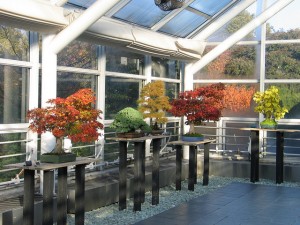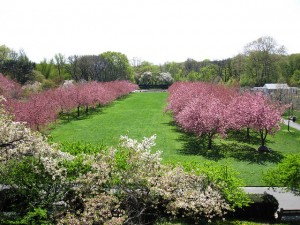My recent trip to Brooklyn wasn’t all the insides of courtrooms and the outsides of container terminals, oh no.

One day, Mrs Friendoftheblogpaul — who knows a good walk when she sees one — suggested we take a wander through Prospect Park and the Brooklyn Botanical Garden.
I’ve always preferred Prospect Park to Central Park. Partly for reasons of borough pride, of course; but also because I was touched as a teenager by Tom Stoppard’s masterpiece, Arcadia.

Among other things, Arcadia is about landscape gardening and the emergence of the Romantic style over the Classical. And set against its Manhattan sibling, Prospect Park does present a certain Gothic ruggedness. Like in Central Park, an assortment of international types are kicking each other in the air and crumpling to the ground in anticipation of their heroes bravely doing the same for the motherland in Brazil.
But take a quiet path wending through the woods, and you’ll emerge in a quiet lea barely populated by the odd New Yorkers who have the time and inclination to find it. Keep heading south-east and a carousel of Victorian solidity evokes imagined memories of Edenic childhoods.

I’m not coming from that direction. Instead, proving that if you pick up your bags and charge at New York from an odd angle, you’ll find something magic, I cleave to the eastern fence. Passing through the turnstile, I’m at the top of stairs that sweep down into the Prospect Park Zoo, where sea lions whirl like débutantes in Sea Lion Court. Sheep wait to lick my open palm clean of kibblish pellets with sandpaper-soft tongues. Goats shout at each other like humans doing impressions of goats doing impressions of humans. Kids peer out of plastic bubbles set into Prairie Dog Hill, like lunar meerkats.
Across the road, the Brooklyn Botanical Garden abandons gothic romanticism. It reflects an America that, for all its mythology of the frontiersman and the cowboy, is obsessed with order and Doric columns.
The BBG is flanked by the Brooklyn Museum, designed by classicists and Beaux-Artistes McKim, Mead & White to be “the focal point of a planned cultural, recreational, and educational district for the burgeoning city of Brooklyn” that was greatly reduced in scope upon the borough’s union with the city of New York.

Entering the BBG through the Osbourne Garden, one is confronted with trompe l’oeil pillars falling away in size to present a greater sense of scale. At the bottom of the hill are the Rose Garden and the Cherry Esplanade, where couples loll as youngsters run amok. The Japanese Hill and Pond Garden curls towards the southern border of the gardens, where the Shakespeare Garden (in the English cottage-garden style) and the Fragrance Garden lead to the Palm House and the acme of order that is the C.V. Starr Bonsai Museum.

The history and discipline of bonsai is varied and complex, even if the BBG does a good job of pruning it down for the casual Scottish stroller. Wikipedia’s miniaturised summary is appealing, too:
The purposes of bonsai are primarily contemplation (for the viewer) and the pleasant exercise of effort and ingenuity (for the grower).
I was particularly taken by the museum’s focus on bonsai as a miniaturised and idealised landscape in the Vietnamese tradition. Learning more, I discovered that bonsai aesthetics are informed by Friendoftheblogron’s fave concept, Wabi-sabi — described by Leonard Koren as “the most conspicuous and characteristic feature of traditional Japanese beauty…. [I]t occupies roughly the same position in the Japanese pantheon of aesthetic values as do the Greek ideals of beauty and perfection in the West”.
The aesthetic of Wabi-sabi is anchoered by the acceptance of transience and imperfection. Thus, the key principles of bonsai aesthetics include miniaturisation, proportion, asymmetry, the absence of the hand of the artist, and a poignancy, or expression of mono no aware.

Leaving the Palm House, I sketched a haiku which I would like to think isn’t devoid of those aesthetics:
size and age mean naught
to the towering bonsai
who just wants to be
Like each of the haiku I write for Mrs Stroke Bloke, the poem follows a strict 5-7-5 syllable pattern. (And any reference to the season is opaque as best, but that seems traditional.) This rigid approach forces upon the inexperienced haiku-writer a contemplation of the interplay of language’s form and content.
Meanwhile, Mrs S-B was back in Edinburgh picking up a book I had asked my new favourite independent bookstore (the wonderfully-curated Golden Hare Books) to hold for me: The Essential Haiku: Versions Of Bashō, Buson & Issa, by Robert Hass. In it, Hass writes that these three great masters of the form respectively demonstrate poignant calm and spiritual restlessness, painterly precision and strangeness, and pathos and humour. I’m looking forward to learning how they construct their poems so that I can humbly enjoy new forms of the pleasant exercise of effort and ingenuity in my own haiku.

It is, of course, after learning within guidelines and restrictions that one can branch out and play with the form — Picasso being the axiomatic example. Mrs S-B and I were recently talking with a nice young couple (the couple are young, and so is their coupling). Mrs S-B, harking back to her days as the Stern School of Business’s resident Dan Savage, mentioned the importance of partners simply being nice to each other — saying “thank you,” for example, and being appreciative. It’s after mastering these seemingly simple skills, I suppose, that one can move on to the varsity level stuff.
And with that, this short return to Edinburgh ends and I head to Brooklyn for one last, short trip. For now. Thank you for reading; I wish My Love — and you — an awareness of the transience of all things, that heightens appreciation of their beauty.






I was hanging out with some cosmologists lately and they were explaining theories of variable density in the universe. Most of the unicerse does t have stuff. Some parts, like here, do. Turns out matter flows down density ropes to sort of node like wells where the stuff is
So I ask what fills up the ropes. How does stuff get out of the wells
And the answer is it doesn’t. These ropes sort of started and have been trickling since the big bang.
Even the universe sort of only gets one shot at it basically
If you hang out with cosmologists enough you start wondering what happened before 10^-37 seconds or what not. Then it gets confusing
So I guess what I’m saying is: everything is transient at some time scale.
And, conversely, everything is well approximated as static at some other time scale.
Physics: ruining it for everyone since 1675!
Yeah, and then there’s the question of what “time” is in the first place. I started listening to a BBC R4 In Our Time on the subject, thinking, this is right up my street. But I’ll have to see if it’s still available, ‘cos it was denser than the densest density rope, and this was back in… 2008-09? My brain was already being pulled apart like Jon Osterman in an intrinsic field experiment test chamber (that’s what happens when you hang out with cosmologists). Apparently, it’s all a bit timey-wimey.
But the science may not be important in this context (while acknowledging its vital role in allowing us to make informed decisions). Returning to the prescient Arcadia: as I understand it, modern science and philosophy don’t just suggest that free will is an illusion, they support scientific variations of predetermination. Yet it seems to me that choosing to live as if one does have free will is a good decision, regardless. Similarly, living as if the things we cling onto are transient seems — intuitively at least — to be a liberating idea. Not that I’m sharing any earth-shattering insights here.
Finding a point along the scale of transience for stuff has a value — this too shall pass. I’ve written previously about my neuropsych who suggested the useful tool that, if a thing (i) isn’t going to be a problem in two years’ time, then don’t let it consume you, (ii) is going to be a problem in two years’ time, you need to start addressing it. It’s oversimplified, clearly, but it seems like a good rule of thumb for forcing perspective.
In addition to my slight obsession with “wabi-sabi” as an adult, I had a slight obsession with bonsai as a child. In a roundabout way, that reminds me of a recent walk I took.
It’s not so much that the walk itself was particularly colourful (though it did include sights like the man huffing paint and gang of children way too hardened for their young age… the oldest, a boy maybe 8 years old with died blond hair and playing with a lighter, the youngest a naked toddler who should not have been wandering along a busy street), but, in this case, the interesting element was the destination.
I decided to walk to the shrine of a famous, powerful ghost called Mae Nak Phra Khanong. Most Thais majorly believe in and fear ghosts, and she’s the most well known of all. Her story’s been made into movies and TV series something like 9 times. Brilliant love story with some blood-curdle for good measure.
Multiple variations but here’s the story more or less:
Nak is a beautiful young woman living with her husband Mak in a stilted house over the Phra Kanong Canal in Bangkok about 150 years ago. Mak is drafted and sent off to war against the Shan people while his wife is pregnant. Mak is seriously wounded and away for an extended time as he’s nursed back to health.
Unbeknownst to Mak, his wife Nak and the baby die in childbirth. (Pregnant women make extra-fearsome ghosts.) Madly in love with her husband and not willing to let go, Nak sticks around. She welcomes Mak back home and introduces him to his baby. Whenever the villagers try warn Mak that his wife is a ghost, she kills them.
Eventually, he discovers what’s up. Nak is making dinner and drops a lime off the verandah, and she reaches out with an Inspector Gadget arm to pick it up off the ground. (Remember this is a stilted house.) He suddenly realises she’s a ghost (or maybe he knew all along but didn’t want to admit it?). Later that night he escapes by telling her he has to go take a leak and then running off through the trees. She gives chase. He hides himself behind a certain kind of tree that protects you from ghosts and then makes a break for the sacred ground of a temple.
Heartbroken Nak flies into a rage, taking it out on the villagers. A powerful monk-exorcist comes and traps her in an earthen jar and disposes of it in canal.
Of course, eventually a couple people come across the jar and accidentally free her spirit. The monk comes back and traps her in her own forehead bone, which some people say is held by the Royal Family.
The less Romantic origin of the tale (and not widely known) is that it was probably/possibly a fabricated ghost story that arose out of a family inheritance dispute… an attempt to scare scare away gold diggers.
Oh – and the fruits of the walk:
By the time I reached the canal side shrine, it was already closed for the day. The statue of Nak was already shuttered – though there were plenty of drawings of her and various offerings all around the shrine. I’ll head back eventually.
The bonsai connection? In a lot of Asia, ghosts often live in trees. Especially female ghosts. You’ll find trees wrapped up in lots of colourful scarves with offerings beneath them. Maybe you saw some of these while you were here.
Thanks for sharing, Ron. That’s great stuff. I’d be interested to know if you have any reflections on Shinto and its associated kami way up to the north east, in Japan…?
Ohhh, no. Know very little about kami and Shinto. So no reflection really. Except that those kind of spirits are a completely different beast from the ones you often see in Southeast Asia and South Asia. At least I think they are?
Why should not knowing much about a subject prevent you from asserting an opinion anyway?58
Ha! You’re coming to it unburdened by the distortion of knowledge! Shinto does seem to be somewhat sui generis, notwithstanding its adaptation and reaction to the colonising power of Buddhism.
(Apparently, it doesn’t prevent me from asserting an opinion at all!)